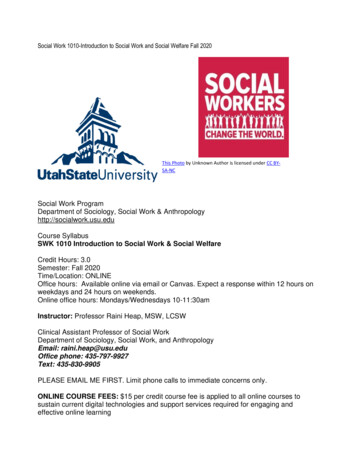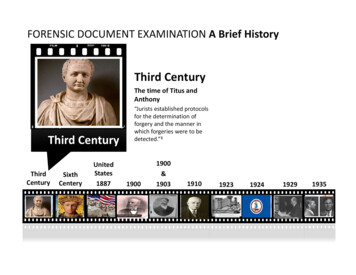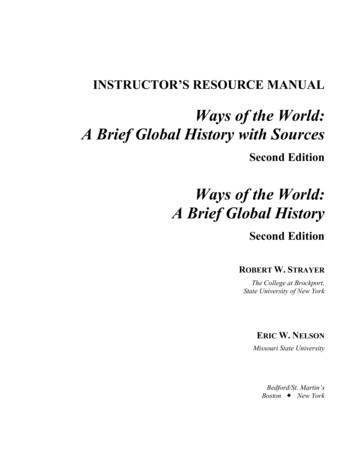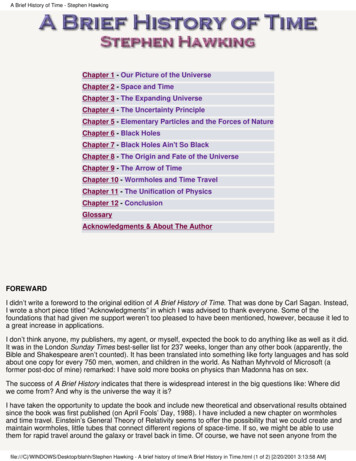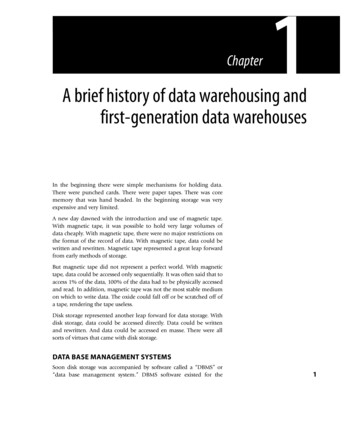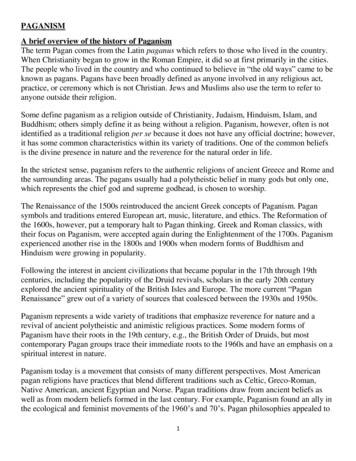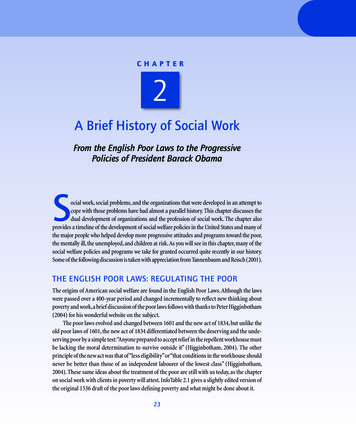
Transcription
CHAPTER2A Brief History of Social WorkFrom the English Poor Laws to the ProgressivePolicies of President Barack ObamaSocial work, social problems, and the organizations that were developed in an attempt tocope with those problems have had almost a parallel history. This chapter discusses thedual development of organizations and the profession of social work. The chapter alsoprovides a timeline of the development of social welfare policies in the United States and many ofthe major people who helped develop more progressive attitudes and programs toward the poor,the mentally ill, the unemployed, and children at risk. As you will see in this chapter, many of thesocial welfare policies and programs we take for granted occurred quite recently in our history.Some of the following discussion is taken with appreciation from Tannenbaum and Reisch (2001).THE ENGLISH POOR LAWS: REGULATING THE POORThe origins of American social welfare are found in the English Poor Laws. Although the lawswere passed over a 400-year period and changed incrementally to reflect new thinking aboutpoverty and work, a brief discussion of the poor laws follows with thanks to Peter Higginbotham(2004) for his wonderful website on the subject.The poor laws evolved and changed between 1601 and the new act of 1834, but unlike theold poor laws of 1601, the new act of 1834 differentiated between the deserving and the undeserving poor by a simple test: “Anyone prepared to accept relief in the repellent workhouse mustbe lacking the moral determination to survive outside it” (Higginbotham, 2004). The otherprinciple of the new act was that of “less eligibility” or “that conditions in the workhouse shouldnever be better than those of an independent labourer of the lowest class” (Higginbotham,2004). These same ideas about the treatment of the poor are still with us today, as the chapteron social work with clients in poverty will attest. InfoTable 2.1 gives a slightly edited version ofthe original 1536 draft of the poor laws defining poverty and what might be done about it.23
InfoTable 2.1 A Slightly Edited 1536 Draft of the Poor Laws Explaining Who IsPoor and Why They Need HelpFor as much as the king has full and perfect notice that there is within his realm agreat multitude of strong valiant beggars [comprised of]: (1) vagabonds and idlepersons, who might labor for their living but unlike your other loyal servants, live idlyby begging, to the high displeasure of Almighty God, the hurt of their own souls, theevil example of others, and to the great hurt of the commonwealth of this realm; asare (2) the old, sick, lame, feeble and impotent persons not able to labor for their living but are driven of necessity to the charity of the people. And his highness (3) hasperfect knowledge that some of them have fallen into such poverty (4) through sickness and other casualties, and some through their own fault, (5) whereby they havecome finally to that point that they could not labor for any part of their living but aredriven by necessity to live by the charity of the people. And some have fallen to suchmisery because they have been released from work by their employers because of sickness, leaving them without relief and comfort. Some have been neglected by friendsand family and have developed idleness and the belief that they can live well withoutworking. Some have even been taught to beg from childhood. And so for lack of goodoversight in youth, many live in great misery as they age. And some have come to suchmisery through sloth, pride, negligence, falsehood and such other ungraciousness,whereby their employers, lovers and friends have been driven to forsake them until noone would take them to any service; whereby they have in process of time lain in theopen streets and fallen to utter desolation. But whatever the reason is, charity requiresthat some way be taken to help them and prevent that others shall not hereafter fallinto like misery. Therefore, his highness and the Parliament assembled [are asked to]provide certain remedies for the poor and miserable people, in the following manner. . . written by William Marshall (1536).Under the 1601 Act, each parish (equivalent to a small county) was ordered to helpthe elderly and the infirm, to bring up needy children with a work ethic, and to providework for others without a trade or those who were unemployed. The main objectives ofthe 1601 Act were:The establishment of the parish as the administrative unit responsible for poor relief,with churchwardens or parish overseers collecting poor-rates and allocating relief.The provision of materials such as flax, hemp, and wool to provide work for the ablebodied poor.The setting to work and apprenticeship of children.The relief of the “impotent” poor—the old, the blind, the lame, and so on. This couldinclude the provision of “houses of dwelling”—almshouses or poorhouses rather thanworkhouses.Any able-bodied pauper who refused to work was liable to be placed in a “House ofCorrection” or prison.SOURCE: Reprinted with permission of Peter Higginbotham.24 PART I SOCIAL PROBLEMS, THE SOCIAL WELFARE SYSTEM, AND THE ROLE OF PROFESSIONAL SOCIAL WORK
Much like current efforts to put those on welfare back to work, the workhouses were meantto stimulate a work ethic and to provide food, clothing, shelter, and medical care, but the realityof the workhouses was altogether different, as the description in InfoTable 2.2 indicates.InfoTable 2.2 The WorkhousesWhatever the regime inside the workhouse, entering it would have been a distressingexperience. New inmates would often have already been through a period of severehardship. It was for good reason that the entrance to the Birmingham Union workhousewas through an arch locally known as the “Archway of Tears.” . . . The inmates’ toiletfacilities were often a simple privy—a cess-pit with a simple cover having a hole in it onwhich to sit—shared perhaps by as many as 100 inmates. Dormitories were usuallyprovided with chamber pots or, after 1860, earth closets—boxes containing dry soilwhich could afterwards be used as fertiliser.SOURCE: Reprinted with permission of Peter Higginbotham.Under the 1834 act, illegitimate children were the responsibility of their mothers until theywere 16 years old. If mothers were unable to support themselves and their children, they usuallyentered the workhouse whereas the father was free of responsibility for his illegitimate children,a notion that continues to this day in the United States and is felt to be responsible for thefeminization of poverty, even among legitimate children and mothers who have child supportdecrees from the court that are all too often ignored by fathers. Fortunately, this 1834 law onillegitimate children was unpopular and was replaced with a subsequent act in 1844 (7&8 Vic.c. 101) allowing an unmarried mother to order the father to pay for maintenance of the motherand child, whether or not she was receiving poor relief.The poor laws changed as times and the horrific conditions in the workhouses led thepublic to increasingly believe that the workhouses were shameful and that the British peopledeserved a much kinder and more humane approach to helping all people in times of economicand health concerns. InfoTable 2.3 provides a scathing criticism of the poor laws. As a result,Britain became one of the leading countries to institute free health care and other highlythought-of social services and became an important model for many social programs duringPresident Roosevelt’s New Deal (1933–1945).InfoTable 2.3 A Criticism of the Poor Laws Written in 1817The clear and direct tendency of the poor laws, is . . . not, as the legislature benevolentlyintended, to amend the condition of the poor, but to deteriorate the condition of bothpoor and rich. . . . If by law every human being wanting support could be sure to obtainit, and obtain it in such a degree as to make life tolerably comfortable, theory wouldlead us to expect that all other taxes together would be light compared with the singleone of poor rates. The principle of gravitation is not more certain than the tendency ofsuch laws to change wealth and power into misery and weakness.SOURCE: Ricardo (1817, pp. 35–40).CHAPTER 2 A B rief History of S ocial Work25
A Brief Overview and Timeline of the English Poor LawsAD 1300–1562 Large tracts of English land were set aside for sheep farming to produce wool.This dislocated many people who became an underclass of dispossessed poorwandering the countryside seeking work, settlement, and charity. A population increase of 25% and a series of famines led to increased poverty, whichcould not be dealt with using the old system of individual charity.1563–1601 In an attempt to provide a system of assistance to a growing number ofimpoverished citizens and because of concern that civil disobedience andchaos would result in civic deterioration, the English Poor Laws of 1563, 1572,1576, 1597, and 1601 were created. In 1563 the poor were categorized for the first time into deserving(the elderly and the very young, the infirm, and families who occasionallyfound themselves in financial difficulties due to a change in circumstance), who were considered deserving of social support, and theundeserving (those who often turned to crime to make a living, such ashighwaymen or pickpockets, migrant workers who roamed the countrylooking for work, and individuals who begged for a living), who were tobe treated harshly. The act of 1572 introduced the first compulsory localpoor law tax, an important step acknowledging that alleviating povertywas the responsibility of local communities. In 1576 the concept of theworkhouse was born, and in 1597 the post of overseer of the poor wascreated. The great act of 1601 consolidated all the previous acts and setthe benchmark for the next 200 years. (“A Brief Explanation of thePoor Law,” n.d., para. 4)1601–1834 During these years a system was devised and rules were developed thatprovided “poor relief ” by local authorities and depended on legal residencein a locale with provisions to help determine whether someone would stayor leave the “protection” of the poor laws administrator. Emphasis wasplaced on work, apprenticeships, and other means to determine that onehad become a contributing citizen. If character issues were noted thatsuggested a person was not deserving of help he or she could be removedfrom assistance.After 1834 The poor laws went from being a local administrative responsibility to ashared one where communities could band together to provide assistance.Workhouses rather than any assistance in kind (food, shelter, clothing,small money grants) became the primary way of assisting the poor. It wasnot until 1930 that the poor laws were finally abolished. The following rulesand conditions (Bloy, 2002, para. 1) were standardized by the Poor Lawsof 1834: After the 1834 Poor Law Amendment Act had been passed, the Poor LawGuardians had to provide accommodation for paupers. They did this bybuilding “workhouses.” The aim of the workhouse was to discourage peoplefrom claiming poor relief, and conditions were to be made as forbidding aspossible. Residents of poor houses were segregated by age and gender.Married couples, even the elderly, were to be kept apart so that they could not“breed.” The old, ill, insane, slightly unbalanced, and fit were kept together26 PART I SOCIAL PROBLEMS, THE SOCIAL WELFARE SYSTEM, AND THE ROLE OF PROFESSIONAL SOCIAL WORK
both day and night with no form of diversion. Inmates simply sat and didnothing if they were not working. The daily schedule was as follows:5:00 A.M.Rising Bell6:00 A.M.—7:00 A.M.Prayers and Breakfast7:00 A.M.—12 noonWork12 noon—1:00 P.M.Dinner1:00 P.M.—6:00 P.M.Work6:00 P.M.—7:00 P.M.Prayers7:00 P.M.—8:00 P.M.Supper8:00 P.M.BedMeals were as dull, predictable, and tasteless as poor cooking and no imagination could makethem. Often the quantity, quality, and lack of nutrition meant that workhouse inmates were on aslow starvation diet.After 1930 Although the laws changed in England and the inhumane treatment of thepoor gave way to the progressive changes in the way the society viewedpoverty, many of the cruel ideas about the poor continue on in both Englandand America. Later in the book you’ll read about compassionate conservatism (Chapter 25), where the writer (Magnet, 1999, para. 9) urges a changein the way we provide assistance to the poor: Since some women will still have illegitimate children despite renewedstigma, Gov. Bush has just set up four pilot residential hostels forwelfare mothers and their babies—tough-love institutions, not handouts for the irresponsible, that will focus on making sure the babiesget the nurture they need to be able to learn and to succeed, somethingthat young welfare mothers often don’t know how to provide. Privategroups run the hostels—including, thanks to the “charitable choice”provision in the 1996 welfare reform act, a church-related group. Theyare able to provide the clearly, enunciated moral values that theirresidents, like most social-service clients, need to live by.Sound familiar? Some bad ideas apparently never go away.THE AMERICAN EXPERIENCEEven before the American Revolution, services to the poor, to children, and to the mentally illhad been established in North America, many using the poor laws established in England todefine who should receive services and the content of those services. By the early 19th century,states had begun providing relief through towns and counties. Because their efforts were ofteninadequate, private benevolent societies and self-help organizations began to supplement theirefforts. These benevolent societies were the predecessors of modern social service agencies.InfoTable 2.4 provides a description of the condition of mental institutions, as they were calledin the 19th century, and one woman’s work in bringing about change. InfoTable 2.5 considerswhether the condition in hospitals for the mentally ill have improved since the 19th century.CHAPTER 2 A B rief History of S ocial Work27
InfoTable 2.4 D orothea Dix and the Condition of American Mental Institutionsin 1840In March 1841, Dorothea Dix entered the EastCambridge, Massachusetts, jail, where she witnessed such horrible images that her life, fromthat point on, was changed forever. Within theconfines of this jail she observed that prostitutes, drunks, criminals, retarded individuals,and the mentally ill were all housed together inunheated, unfurnished, and foul-smelling quarters (Viney & Zorich, 1982). When asked whythe jail was in these conditions, she was toldthat the insane do not feel heat or cold.Dix proceeded to visit jails and almshouseswhere the mentally ill were housed. She madecareful and extensive notes as she visited withjailers, caretakers, and townspeople. Finally, shecompiled all these data and shaped a carefully Dorothea Dix, early activist for theworded document to be delivered to the mentally ill.Massachusetts Legislature. After a heateddebate over the topic, the material won legislative support, and funds were set asidefor the expansion of Worcester State Hospital (Bumb, n.d.).SOURCE: Bumb (n.d.).InfoTable 2.5 Are We Doing Better Now?In a report by the U.S. Justice Department in its 2005 review of California institutionstreating the mentally ill, as cited by Lopez (2005, p. A1), it was noted that therapistsand employees had been accused of sexually assaulting patients, patients were murderedby other patients, and “between January and June 20, 2003, one patient assaulted 20other patients. Staff were afraid of this patient and failed to intervene to protect otherpatients.” The report described inadequate toilet facilities, patients dying for unknownreasons, unsupervised patients committing suicide, and, on the testimony of a physician,staff at one hospital bringing drugs to the facility in exchange for cash. One wondershow Dix would view the progress made in even the past 30 years since the publicationof “On Being Sane in Insane Places” (Rosenhan, 1973), where researchers at a statehospital faked being mentally ill and observed the maltreatment and lack of professionalconduct of the staff to such an extent and to such a public outcry that American hospitals for the mentally ill were largely emptied and people began changing their locationof being warehoused from the hospital to the streets and inner cities of the United States.SOURCE: Undated portrait of Dorothea Dix, 19th-century advocate for the rights of the mentally ill.Courtesy of University of North Carolina at Chapel Hill, http://www.learnnc.org/lp/multimedia/1175128 PART I SOCIAL PROBLEMS, THE SOCIAL WELFARE SYSTEM, AND THE ROLE OF PROFESSIONAL SOCIAL WORK
Those who worked or volunteered in benevolent societies were often upper-class womenand men, often known as “friendly visitors,” who used moral persuasion and personal exampleas helping devices. While I was a student social worker in the MSW program at the Universityof Washington in 1963, my field placement in the Seattle public schools still used the termfriendly visitor to designate who we were and what we did. How little things change.As social work became more interested in the conditions that created social problems,“organizations such as the Association for the Improvement of the Condition of the Poor andthe Children’s Aid Society began investigating social conditions in areas such as tenementhousing and child welfare” (Tannenbaum & Reisch, 2001, para. 3).THE ORIGINS OF MODERN SOCIAL WORKIn the half-century after the Civil War, economic depressions, racism, and drastic increasesin immigration from southern and eastern Europe prompted an awareness of the need forsocial programs and helping organizations to assist millions of people who were experiencing economic and social displacement. The recognition of serious social problems followingthe Civil War led to what was then called “scientific charity,” an attempt to use conceptscommon to business and industry to cope with larger social problems. Tannenbaum andReisch (2001) note that although many clients receiving help from the first of these scientificcharities, such as the American Charity Organization organized in Buffalo, New York, in 1877,benefited, many preferred the more personal approaches offered through self-help groupsand community mutual aid. This distinction between large-scale efforts to resolve socialproblems and a more individualized approach set the stage for the earliest notions of thehelping process in social work—one that combines a personalized service with an understanding that environments and social policies need to be improved if individuals are to betruly served.A more highly personalized approach to helping is noted in the development of the settlement house movement, begun in 1886 with the Neighborhood Guild in New York City and madefamous by the best known of the settlement houses, Jane Addams and Ellen Gates Starr’s muchadmired Hull House in Chicago. Settlements focused on the causes of poverty and expandingjobs for the poor. See InfoTable 2.6 for a more complete description of Hull House. They also“conducted research, helped develop the juvenile court system, created widow’s pension programs, promoted legislation prohibiting child labor, and introduced public health reforms andthe concept of social insurance” (Tannenbaum & Reisch, 2001, para. 8). By 1910, the settlementhouse movement had more than 400 individual settlements, many serving newly immigratedgroups, which led to the creation of national organizations such asthe Women’s Trade Union League, the National Consumers’ League, the Urban League, and theNational Association for the Advancement of Colored People (NAACP). Settlement leaderswere instrumental in establishing the Federal Children’s Bureau in 1912, headed by JuliaLathrop from Hull House. Settlement leaders also played key roles in the major social movements of the period, including women’s suffrage, peace, labor, civil rights, and temperance.(Tannenbaum & Reisch, 2001, para. 9)WWWCHAPTER 2 A B rief History of S ocial Work29
The settlement movement put much of its efforts into what we now call macrosystemchange. Macrolevel change reflects change at the community, state, and even national level. Wewould now call the approaches used by the settlement movement “group work” and “communityorganization.” The Charity Organization Society (COS) began to focus on individual work, orwhat became known in the profession as casework with individuals, families, and groups.Casework developed areas of specialization including medical, psychiatric, and child caseworkand led to the development of a formal training program created by the New York COS in 1897in partnership with Columbia University. By 1919, there were 17 schools of social work identifying themselves collectively as the Association of Training Schools of Professional Social Work,the precursor of today’s Council on Social Work Education (CSWE).During and after World War I, the American Red Cross and the U.S. Army gave social workers an opportunity to work with populations who were not impoverished but were sufferingfrom war-related problems, including what was then called shell shock or what we now callposttraumatic stress disorder (PTSD). This new population of clients led to social workersinteracting directly with individuals and families. By 1927, social workers were practicing inmore than 100 guidance clinics with primarily middle-class clients in teams composed of socialworkers, psychiatrists, and psychologists. At the same time, social workers were employed inCommunity Chest, the organization that led the way to the United Fund and its health andwelfare councils.InfoTable 2.6 Hull HouseThe Hull House community believed that poverty and the lack of opportunity bred theproblems of the ghetto. Ignorance, disease, and crime were the result of economicdesperation and not some moral flaw in the character of the new immigrants. JaneAddams promoted the idea that if afforded a decent education, adequate living conditions, and reliable income, any person could overcome the obstacles of the ghetto;furthermore, if allowed to develop his skills, that person could not only make a betterlife for himself but contribute to the community as a whole. Access to opportunity wasthe key to successful participation in a democratic, self-governing society. The greatestchallenge and achievement of the settlement was to help people help themselves.SOURCE: Jane Addams Hull House Association (2009).THE GREAT DEPRESSION AND THE NEW DEALIn October 1929, the stock market crashed, wiping out 40% of the paper value of common stock.Four years later, a common stock, if it were still negotiable, was equal to one fifth of its worthbefore the Great Crash. Although politicians continued to issue optimistic predictions aboutthe nation’s economy, the Depression deepened, confidence evaporated, and many lost their lifesavings. Businesses closed their doors, factories shut down, and banks failed. Farm income fellby 50%, and by 1932, one out of every four Americans was unemployed.30 PART I SOCIAL PROBLEMS, THE SOCIAL WELFARE SYSTEM, AND THE ROLE OF PROFESSIONAL SOCIAL WORK
In 1933, Franklin D. Roosevelt (FDR) introduced the New Deal, a social and economicprogram of recovery using the government as an instrument of change, an approach familiarto many Europeans for more than a generation. The New Deal ended laissez-faire capitalismand introduced the regulation of business activities, banking reform, and the ability of laborto organize and apply collective bargaining in its pursuit of fair wages and working conditionsthrough passage of the National Labor Relations Act of 1935.By 1933, millions of Americans were out of work, and bread lines were a common sight inmost cities. An early attempt to reduce unemployment came in the form of the CivilianConservation Corps (CCC), a program to reduce unemployment in young men aged 18 to 25years. Paid a dollar a day, 2 million young men took part in the CCC during the decade, participating in a number of conservation projects that affect us today: planting trees to combatsoil erosion and maintain national forests; eliminating stream pollution; creating fish, game,and bird sanctuaries; and conserving coal, petroleum, shale, gas, sodium, and helium deposits.The New Deal years were characterized by a belief that greater regulation would solve manyof the country’s problems. With new agricultural policies in place, farm income increased bymore than 50% between 1932 and 1935. Only part of the reason for the increase can be explainedby new federal programs, however. A severe drought affected the Great Plains states, significantly reducing farm production. Violent dust storms hit the southern area of the Great Plainsfrom 1935 to 1938 in what became known as the Dust Bowl. Crops were destroyed, cars andmachinery were ruined, and people and animals were harmed. Approximately 800,000 peopleleft Arkansas, Texas, Missouri, and Oklahoma during the 1930s and 1940s. Most headed fartherwest to the land of milk and honey, California.One of the most widely heralded programs of the New Deal was the creation of the SocialSecurity Act, which provided a safety net in the form of a small pension for workers who contributed to the program. Although it was never intended to provide a complete pension, manyworkers failed to save enough to be fully retired. InfoTable 2.7 describes the remaining problemswith Social Security today.InfoTable 2.7 Problems Remain for the Social Security of AmericansWe cannot be satisfied with the Social Security protection now provided to Americans.Retirement benefits in our old age and survivors’ insurance systems supply only onethird as much income, or less, to the workers no longer able to work as that enjoyed byolder people still in employment. Although the benefits under state laws to unemployedand injured workers are greater, our unemployment insurance and workmen’s compensation laws also are very much in need of liberalization and improvement. None of oursocial insurance programs is as broad in coverage as it should be. Great risks, like earlydisability and prolonged sickness, lack all governmental protection; and the voluntaryforms of insurance we have, although most valuable, do not protect many of those whomost need protection. The great objective of Social Security—assurance of a minimumnecessary income to all people in all personal contingencies of life—has not beenattained even in this great country in which the common man fares better than in anyother (Witte, 1955).CHAPTER 2 A B rief History of Social Work31
The Works Progress Administration (WPA) provided work rather than welfare to thenation’s unemployed. Under the WPA, buildings, roads, libraries, airports, courthouses, cityhalls, and schools were constructed. Actors, painters, musicians, and writers were employedthrough the Federal Theatre Project, the Federal Art Project, and the Federal Writers’ Project.The National Youth Administration provided part-time employment to students and unemployed youth. By the time it was abandoned in 1943, the WPA had helped 9 million people.Prior to the Great Depression, the social welfare system was a combination of local publicrelief agencies with some modest help from charitable organizations. Because the public nowsaw poverty as the result of economic problems rather than personal shortcomings, theDepression defined government’s role in helping people whose economic situation was troubled. This change in the role of government prompted numerous government programs underthe Roosevelt administration, which ultimately led to our present social welfare system. Socialworkers such as Harry Hopkins and Frances Perkins, who were part of the Roosevelt administration, enhanced the status of the social work profession.The most significant program, and the centerpiece of dozens of social welfare programsthat comprised the Roosevelt administration’s New Deal, was the Social Security Act of 1935.It gave recipients a social welfare net that provided retirement income and protection againstcatastrophic economic problems. As a result of the New Deal, social welfare went beyond reliefto the poor to include housing, electricity, roads and dams for rural problem areas, healthprograms, child welfare programs, and many forms of social insurance for all Americans. Thissystem of social programs comprises what is often referred to as the social welfare net, whichprotects all Americans in times of serious social and economic upheavals. These programsled to a significant expansion of the profession and an increased role for social work in themany programs created by government. The number of social workers doubled from 40,000to 80,000 within a decade and led to improved salaries and the need for increased educationalrequirements.PRESIDENT ROOSEVELT’S ECONOMIC BILL OF RIGHTSThe following comes from a speech given by President Franklin D. Roosevelt in 1944 that outlines the thrust of the New Deal legislation on economic security that continued throughouthis presidency (1933–1945). Roosevelt believed that economic security meant the following:The right of a useful and remunerative job in the industries, or shops or farms or mines of thenation;The right to earn enough to provide adequate food and clothing and recreation;The right of every farmer to raise and sell his products at a return which will give him and hisfamily a decent living;The right of every business man, large and small, to trade in an atmosphere of freedom from unfaircompetition and domination by monopolies at home or abroad;The right of every family to a decent home;The right to adequate medical care and the opportunity to achieve and enjoy good health;32 PART I SOCIAL PROBLEMS, THE SOCIAL WELFARE SYSTEM, AND THE ROLE OF PROFESSIONAL SOCIAL WORK
The right to adequate pr
on social work with clients in poverty will attest. InfoTable 2.1 gives a slightly edited version of the original 1536 draft of the poor laws defining poverty and what might be done about it. 2. 24 PART I SOCIAL PROBLEMS, THE SOCIAL WELFARE SYSTEM,
